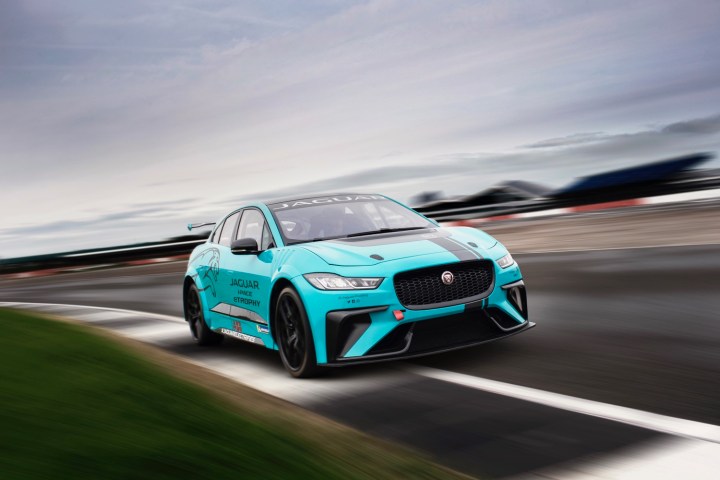 When it comes to its first electric car, the I-Pace SUV, Jaguar is taking the old adage, “win on Sunday, sell on Monday,” to heart.
When it comes to its first electric car, the I-Pace SUV, Jaguar is taking the old adage, “win on Sunday, sell on Monday,” to heart.
The Jaguar I-Pace eTrophy will see drivers line up in identical race-tuned I-Paces on Formula E tracks, during the same weekends as Formula E races. Jaguar claims this series is the “first international championship for production-based electric cars,” although Electric GT is also trying to get its own series off the ground using Tesla Model S race cars.
At 2017 Los Angeles Auto Show, Jaguar debuted its I-Pace eTrophy car alongside the standard I-Pace SUV concept. Coinciding with the reveal, Jaguar Racing announced the first team to compete in its global electric series. Led by three-time IndyCar Champion and Indianapolis 500 winner Bobby Rahal, Rahal Letterman Lanigan Racing will field two cars in the eTrophy series while also competing in the 2018/2019 global Formula E championship.
“Innovation is integral to motorsports and electric car racing is an important part of the future, so this opportunity came at the perfect time for RLL,” commented Rahal.
Jaguar’s I-Pace eTrophy will be what’s known in the business as a “support series.” It will “support” Formula E by giving fans something to watch before a Formula E race, kind of like a warm-up act. Race weekends usually include a lot of downtime, and support series like the I-Pace eTrophy help fill it. Jaguar already runs its own Formula E team, so the arrangement makes sense.
Jaguar says up to 20 I-Pace race cars will participate in each event, which will consist of practice and qualifying sessions, followed by the actual race, which will last 25 minutes plus one lap. Since it uses the same tracks as Formula E, the I-Pace eTrophy will take place on temporary street circuits in major world cities. It will launch as part of Formula E’s fifth season, in late 2018. Formula E itself uses single-seat, open-wheel electric cars that look more like traditional racers than Jaguar’s I-Pace SUV.
The first I-Pace eTrophy race will be held December 15, 2018, in Ad Diriyah, Saudi Arabia. The full calendar also includes races in Mexico City, Hong Kong, Sanya, China, Rome, Paris, Monaco, and Berlin, wrapping up in July 2019 with two back-t0-back rounds in New York City.
Jaguar did not release specifications on the I-Pace race cars, but photos show big rear spoilers and other changes. The cars will be maintained by Jaguar and shipped to each race, so drivers don’t need to do anything except show up. This means Jaguar doesn’t have to recruit teams to run in the series, and the convenience of this “arrive and drive” format should make finding drivers easy. In addition to the regular entrants, Jaguar plans to recruit a VIP guest driver for each race.
It will certainly be funny to see a bunch of SUVs mixing it up on a race track, especially ones with near-silent electric powertrains. But it makes sense to Jaguar: it plans to put the I-Pace on sale next year and, along with sibling brand Land Rover, will sell only hybrid and all-electric vehicles after 2020. Meanwhile, Formula E is reportedly planning a new series called Extreme E for electric SUVs, potentially giving the I-Pace another opportunity to shine.
Update: Added race dates
Editors' Recommendations
- The best electric SUVs
- Porsche 99X Electric Formula E race car carries the weight of great expectations
- I used to be a die-hard petrol-head, but Jaguar’s electric SUV converted me


